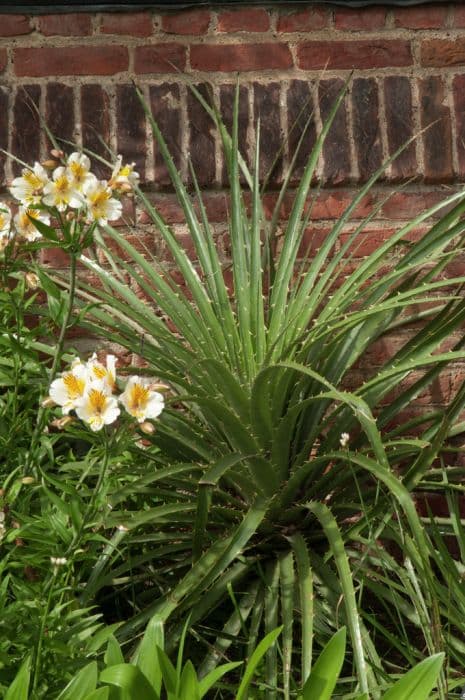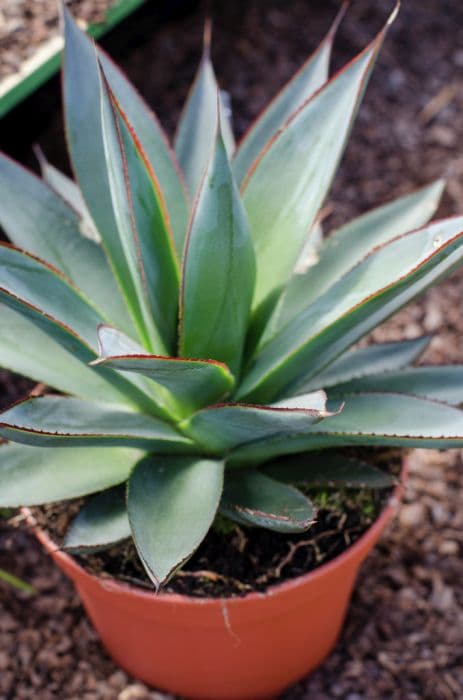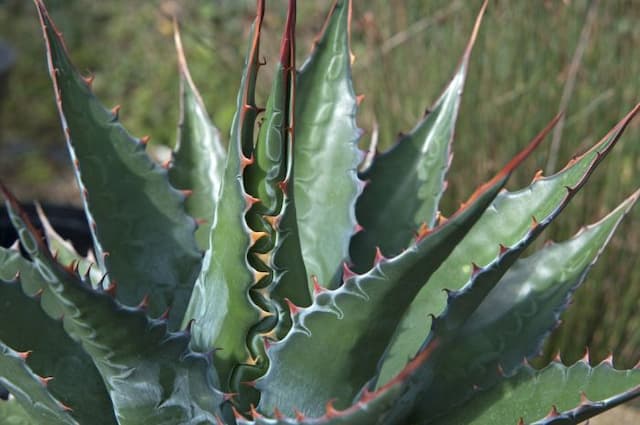Our Lord's Candle Yucca whipplei

ABOUT
The plant known as Our Lord's Candle showcases a rosette of narrow, long, and pointed leaves that are grayish-green in color. The surface of the leaves is somewhat rough with a leathery texture, and their edges are adorned with curly threads. The foliage arrangement gives the plant a spherical appearance. The most striking feature is its impressive flower spike that emerges from the center of the rosette, which is covered in a multitude of creamy white to ivory blooms. These bell-shaped flowers attract a variety of pollinators, including hummingbirds and moths. After flowering, the plant commonly dies, but not before it has produced a substantial number of seeds that fall to the ground, ensuring future generations. The overall aesthetic of Our Lord's Candle is one of stark beauty, well-adapted to arid environments with a sturdy and resilient character.
About this plant
 Names
NamesSynonyms
Our Lord's Candle, Spanish Bayonet, Chaparral Yucca, Quixote Yucca, Foothill Yucca.
Common names
Hesperoyucca newberryi, Hesperoyucca whipplei, Yucca californica, Yucca newberryi.
 Toxicity
ToxicityTo humans
Our Lord's Candle, also known as Yucca whipplei, is considered non-toxic to humans. That being said, consumption of any non-food plant can occasionally cause gastrointestinal irritation, including nausea, vomiting, and diarrhea, in certain individuals if ingested, due to the plant's saponin content. This compound is a natural detergent found in many plants and can cause discomfort in humans if ingested in large quantities. It's essential to exercise caution and not to consume plant parts that are not classified as edible or used in traditional food preparation to avoid any potential adverse effects.
To pets
Our Lord's Candle may pose a risk to pets if ingested as it contains saponins, which are naturally occurring chemicals that can cause gastrointestinal upset, including vomiting and diarrhea. While the plant is not specifically categorized as highly toxic to pets, ingesting significant amounts of the plant can lead to these undesired symptoms due to its saponin content, which acts as a natural deterrent to herbivores. Pets should be discouraged from eating any part of Our Lord's Candle, and if ingestion occurs, monitoring for signs of gastrointestinal distress is prudent. If symptoms do appear, it is advisable to consult a veterinarian.
 Characteristics
CharacteristicsLife cycle
Perennials
Foliage type
Evergreen
Color of leaves
Blue-green
Flower color
White
Height
3-5 feet (0.9-1.5 meters)
Spread
3-6 feet (0.9-1.8 meters)
Plant type
Shrub
Hardiness zones
7
Native area
California
Benefits
 General Benefits
General Benefits- Drought resistance: Yucca whipplei requires minimal water to survive and thrives in arid climates, making it ideal for xeriscaping and low-water landscaping.
- Landscape aesthetics: Our Lord's Candle adds an architectural element to gardens with its unique rosette of sharp, sword-like leaves and striking flower spikes.
- Erosion control: The extensive root system of Yucca whipplei helps stabilize soil and prevent erosion on slopes and in areas susceptible to soil loss.
- Habitat provision: It serves as a habitat and food source for various wildlife species, including pollinators like moths that are attracted to its flowers.
- Low maintenance: Our Lord's Candle is well-suited to low-maintenance gardens due to its ability to withstand neglect, requiring little care once established.
- Fire resistance: Yucca whipplei is fire-retardant and can be used in fire-scaping, helping to protect properties in fire-prone areas.
- Deer resistance: The plant's tough, spiky leaves make it unappealing to deer, which can help protect other garden plants from grazing.
 Medical Properties
Medical PropertiesThis plant is not used for medical purposes.
 Air-purifying Qualities
Air-purifying QualitiesThis plant is not specifically known for air purifying qualities.
 Other Uses
Other Uses- Yucca whipplei, commonly known as Our Lord's Candle, has leaves that can be used to weave baskets and other fibrous crafts. The fibrous strands are strong and durable, making them suitable for creating woven items.
- The flower stalks of Our Lord's Candle can be used as a natural form of paintbrush. When dried, the tips of the stalks can be used to apply paint in broad strokes.
- These plants can act as a natural soap or shampoo as the roots contain saponins. Indigenous people would crush the roots and mix with water to create a lathering solution for cleansing.
- Our Lord's Candle has been utilized in creating waterproof materials. The waxy coating on the leaves helps repel water, and when incorporated into structures or clothing, it adds a degree of water resistance.
- The dried flower stalks are sturdy and can be used as building materials or tools, such as fence posts or for crafting lightweight structures.
- In emergency situations, the flower stalk of Our Lord's Candle can be used as a firestarter, as it is dense and burns slowly once ignited.
- The seed pods of Our Lord's Candle were traditionally used as rattles or noisemakers. The dried pods contain seeds that create sound when shaken.
- The sharp, pointed tips of the leaves can be used as needles or small skewers in a pinch. The natural strength of the leaf material is sufficient for piercing or holding together pieces of material.
- Dried fibrous leaves of Our Lord's Candle have been used as stuffing material for mattresses and pillows in traditional settings, providing insulation and support.
- The rosette shape of Our Lord's Candle offers a potentially interesting structural design element in landscaping. Its striking appearance makes it a focal point in drought-tolerant gardens.
Interesting Facts
 Feng Shui
Feng ShuiThe Our Lord's Candle is not used in Feng Shui practice.
 Zodiac Sign Compitability
Zodiac Sign CompitabilityThe Our Lord's Candle is not used in astrology practice.
 Plant Symbolism
Plant Symbolism- Purity: The delicate white flowers of Our Lord's Candle often symbolize cleanliness and purity, mirroring its serene and pristine appearance.
- Protection: The sharp, spiky leaves suggest resilience and a form of self-defense, symbolizing protection against negative influences or adversity.
- Adaptability: Our Lord's Candle thrives in harsh desert conditions, symbolizing ability to adapt and survive in challenging environments.
- Transformation: This plant has a life cycle where it grows for several years, blooms once spectacularly, and then dies. This can be seen as a symbol of transformation and the beauty of life's fleeting nature.
- Renewal: After Our Lord's Candle blooms and its life cycle ends, it often leaves behind seeds that give rise to new plants, symbolizing renewal and the continuation of life.
 Water
WaterOur Lords Candle (Yucca whipplei) requires minimal watering due to its drought-tolerant nature. It should be watered every two to three weeks during the hot, dry season, ensuring that the soil is allowed to dry out completely between waterings. Reduce watering to once per month or less during the cooler months. When watering, provide enough water to soak the soil around the roots; this could typically be around 1-2 gallons, depending on the size of the plant and the dryness of the soil.
 Light
LightOur Lords Candle thrives best in full sun conditions where it can receive at least 6 to 8 hours of direct sunlight daily. It should be placed in an area where it's exposed to unfiltered sunlight for most of the day. This plant is adept at handling the strong, intense sun of arid climates, and insufficient light can impede its growth and flowering.
 Temperature
TemperatureOur Lords Candle is adapted to a range of temperature conditions and can tolerate maximum temperatures well over 100°F. The plant can survive brief cold snaps as low as 10°F, but ideally, it should be kept in environments where temperatures remain above 30°F. The ideal temperature for thriving growth is between 60°F and 90°F.
 Pruning
PruningOur Lords Candle should be pruned to remove dead flower stalks, which encourages new growth and maintains a tidy appearance. Pruning is best done in the late fall or early winter after the plant has finished flowering. During this time, you can remove old flower spikes and any damaged or dead leaves. Pruning every year or every other year is generally sufficient.
 Cleaning
CleaningAs needed
 Soil
SoilOur Lord's Candle (Yucca whipplei) thrives best in a well-draining soil mix that mimics its native arid conditions. A mix consisting of one-half sand or gravel and one-half potting soil or cactus mix works well. The addition of perlite or pumice can enhance drainage. The ideal soil pH for Our Lord's Candle is slightly alkaline, around pH 7.5 to 8.0.
 Repotting
RepottingOur Lord's Candle (Yucca whipplei) is a slow-growing plant and does not need to be repotted frequently. It should be repotted every 2 to 3 years or when the plant outgrows its current pot. The best time to repot is during the spring or early summer.
 Humidity & Misting
Humidity & MistingOur Lord's Candle (Yucca whipplei) is well adapted to low humidity levels typical of its native arid environments. It prefers dry air and does not require high humidity. It is best to avoid high humidity environments to prevent possible rot or fungal issues.
 Suitable locations
Suitable locationsIndoor
Provide bright light, low humidity, and infrequent water.
Outdoor
Plant in full sun, well-drained soil, and water sparingly.
Hardiness zone
5-11 USDA
 Life cycle
Life cycleYucca whipplei, commonly known as Our Lord's Candle, begins its life cycle when its seeds germinate in well-drained soils, often in early spring. The seedlings develop into a basal rosette of long, narrow leaves, which can take several years to grow, during which the plant stores energy in its stem. Once it accumulates enough resources, typically between 5 to 10 years, it produces a tall flower stalk, sometimes reaching up to 3 meters, which is laden with numerous creamy-white flowers that attract pollinating moths. After flowering, which occurs from late spring to early summer, the plant sets seed and then usually dies, completing its monocarpic cycle. The seeds are then dispersed by wind or wildlife, allowing new rosettes to establish. However, some plants may produce offsets or pups around the base before dying, giving rise to new individuals clonally.
 Propogation
PropogationPropogation time
Spring-Early Summer
Our Lord's Candle, commonly known as Yucca whipplei, is best propagated by seed. The most popular method involves collecting seeds from the plant's spent flower stalks once they have dried and turned brown, which typically happens in late summer or early fall. The seeds can then be sown in well-draining soil in a sunny location. It is crucial to keep the soil moist until germination, which may take several weeks to months. For best results, the seeds should be planted at a depth of about a quarter inch to half an inch (6 to 13 millimeters). The seedlings require patience, as they can be slow to establish, but once they do, they are quite drought-tolerant and low-maintenance.









